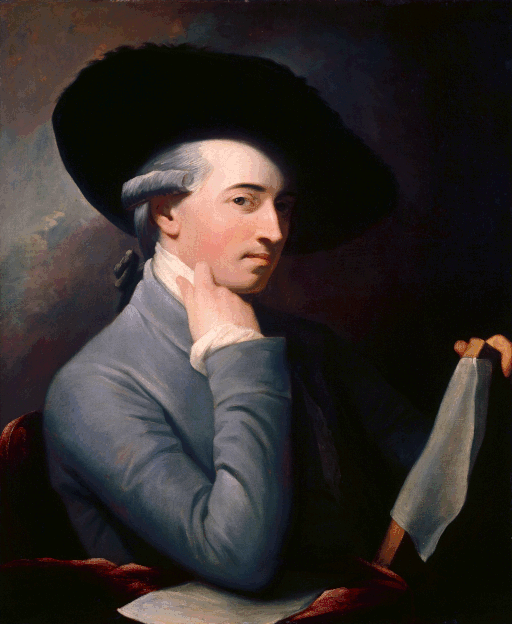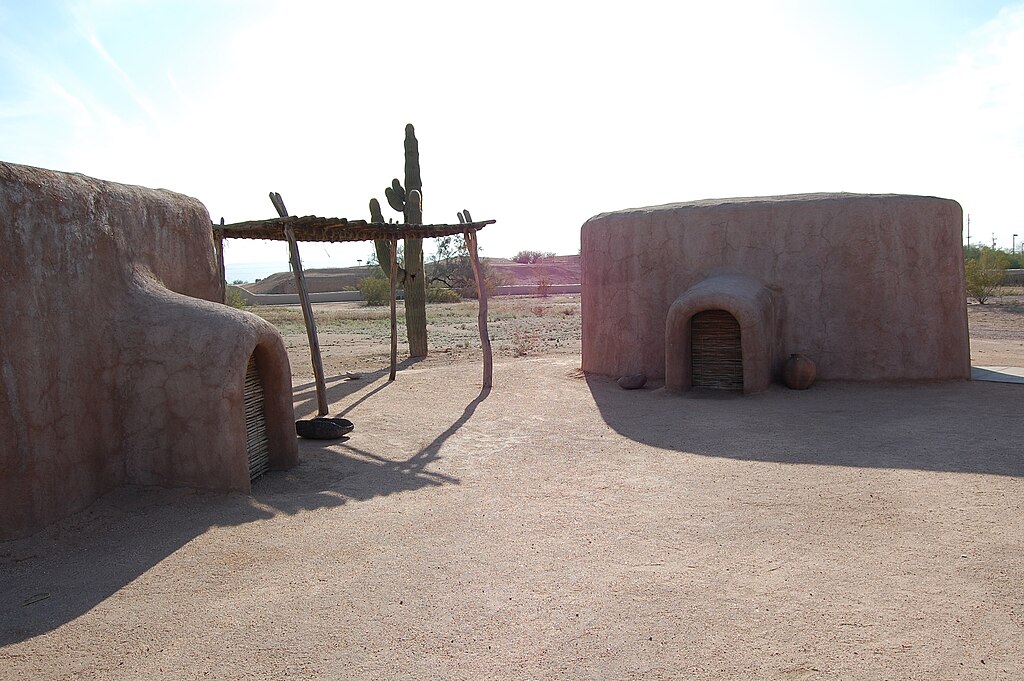
Benjamin West (1738 – 1820) was a British North American artist who painted famous historical scenes. West was born in Springfield, Pennsylvania, as the tenth child of an innkeeper and his wife.
He was entirely self-taught and went on to gain valuable patronage in the American Colonies. Later he toured Europe, eventually settling in London.
The Death of General Wolfe became one of the most frequently reproduced images of the period.
West became known for his history paintings, which used expressive figures, colors, and compositional schemes to help the spectator to identify with the scene represented.
He impressed King George III and was mostly responsible for the launch of the Royal Academy, of which he became the second president after Sir Joshua Reynolds.
He was appointed historical painter to the court and Surveyor of the King’s Pictures.
He was offered a knighthood but declined it, believing that he should instead be made a peer. West died in London and was buried in St Paul’s Cathedral.
Virtual Tour of Benjamin West
- Death of General Wolfe
- The Death of Nelson
- Self-Portrait
- Benjamin Franklin Drawing Electricity from the Sky
- American Commissioners of the Preliminary Peace Agreement with Great Britain
- Joshua passing the River Jordan with the Ark of the Covenant
Highlights Tour of Benjamin West
Death of General Wolfe
“Death of General Wolfe” by Benjamin West depicts the death of British General James Wolfe at the 1759 Battle of Quebec during the French and Indian War.
This painting captures a pivotal event in the Seven Years’ War that decided the fate of France’s colonies in North America. General Wolfe commanded the British Army and successfully held the British line against the French and won the battle.
Unfortunately, General Wolfe was killed by musket wounds.
In death, General Wolfe gained fame as a national hero and became an icon of the Seven Years’ War and British dominance in North America.
This image was so popular that West made an identical painting of the same scene for George III of the United Kingdom, one year after this painting.
In total, four other additional versions of the Death of General Wolfe were also produced by West. Museum: National Gallery of Canada
The Death of Nelson
“The Death of Nelson” by Benjamin West depicts the last moments of Horatio Nelson during the Battle of Trafalgar on the deck of HMS Victory, where a French sharpshooter fatally wounded him.
Nelson’s death at Trafalgar secured his position as one of Britain’s most heroic figures. The significance of the victory and his death during the battle led to his signal, “England expects that every man will do his duty,” becoming famous.
The Battle of Trafalgar in 1805 was a naval engagement fought by the British Royal Navy against the combined fleets of the French and Spanish Navies during the War of the Third Coalition of the Napoleonic Wars (1803–1815).
Twenty-seven British ships led by Admiral Lord Nelson aboard HMS Victory defeated thirty-three French and Spanish ships.
The battle took place in the Atlantic Ocean off the southwest coast of Spain, just west of Cape Trafalgar. The Franco-Spanish fleet lost twenty-two ships, and the British lost none. Museum: Walker Art Gallery
Self-Portrait
“Self-Portrait” by Benjamin West depicts the artists with the light strongest on his face and hands, and the rest of the picture falls into shadow.
West began his career as a portrait painter in Philadelphia and New York. Patrons granted him a scholarship visit Rome, the first American artist to be given this opportunity.
An earlier version of this portrait is exhibited in the Baltimore Museum of Art, which was created in 1770.
This version is from 1776 and is more dramatic in its contrasts. Museum: National Gallery of Art, DC
Benjamin Franklin Drawing Electricity from the Sky
“Benjamin Franklin Drawing Electricity from the Sky” by Benjamin West depicts the American founding father, conducting his kite experiment to ascertain the electrical nature of lighting.
This dramatic painting commemorates the 1752 experiment in Philadelphia in which Benjamin Franklin demonstrated that lightning is a form of electricity.
West was born in Pennsylvania, in 1738, when the American colonies were still part of the British Empire. While he was in London, West befriended Franklin, a fellow Pennsylvanian, but did not create this painting of the American statesman until after his death.
West created this oil on slate, as a study for a larger, but an unrealized portrait. Museum: Philadelphia Museum of Art
American Commissioners of the Preliminary Peace Agreement with Great Britain
“American Commissioners of the Preliminary Peace Agreement with Great Britain,” also known as the “Treaty of Paris,” by Benjamin West, depicts the United States delegation preparing to negotiate and sign the 1783 Treaty of Paris.
The Treaty of Paris, signed in Paris by representatives of King George III of Great Britain and representatives of the United States of America in 1783, ended the American Revolutionary War.
The treaty set the boundaries between the British Empire in North America and the United States of America. Details included fishing rights and restoration of property and prisoners of war.
The unfinished oil sketch by Benjamin West depicts the United States delegation at the Treaty of Paris (left to right): John Jay, John Adams, Benjamin Franklin, Henry Laurens, and William Temple Franklin.
Before ending the American Revolution, the American delegation posed for the painting. The British delegation refused to pose, and the painting was never completed.
Joshua passing the River Jordan with the Ark of the Covenant
“Joshua passing the River Jordan with the Ark of the Covenant” by Benjamin West depicts a key event in Israel’s history.
Just as crossing the Red Sea transformed the peoples of Israel from slavery to freedom, crossing the River Jordan into the Promised Land, transformed Israel into a nation.
After wandering in the desert 40 years, the Israelites finally approached the boundary of the Promised Land.
When the Israelites, led by Joshua toward the Promised Land, arrived at the banks of the Jordan river, the Ark was carried in front of the people and was the signal for their advance.
During the crossing, the river grew dry as soon as the feet of the priests carrying the Ark touched its waters, and remained so until the priests, with the Ark, left the river after the people had passed over.
Self-Portrait
- Title: Self-Portrait
- Artist: Benjamin West
- Year: 1776
- Medium: Oil on canvas
- Dimensions: 75.8 x 63 cm (29 13/16 x 24 13/16 in.)
- Museum: National Gallery of Art, DC
Benjamin West
- Name: Benjamin West
- Born: 1738 – Springfield, Province of Pennsylvania
- Died: 1820 (aged 81) – London, United Kingdom
- Notable works:
- Death of General Wolfe
- The Death of Nelson
- Self-Portrait
- Benjamin Franklin Drawing Electricity from the Sky
- American Commissioners of the Preliminary Peace Agreement with Great Britain
Benjamin West: A collection of 135 paintings
Famous Artists you should Know
- Duccio (1255 – 1319)
- Jan van Eyck (1390 – 1441)
- Giovanni Bellini (1430 – 1516)
- Sandro Botticelli (1445 – 1510)
- Domenico Ghirlandaio (1448 – 1494)
- Leonardo da Vinci (1452 – 1519)
- Albrecht Durer (1471 – 1528)
- Lucas Cranach the Elder (1472 – 1553)
- Michelangelo (1475 – 1564)
- Raphael (1483 – 1520)
- Titian (1488 – 1576)
- Hans Holbein the Younger (1497 – 1543)
- Tintoretto (1518 – 1594)
- Pieter Bruegel the Elder (1525 – 1569)
- Paolo Veronese (1528 – 1588)
- El Greco (1541 – 1614)
- Caravaggio (1571 – 1610)
- Peter Paul Rubens (1577 – 1640)
- Georges de La Tour (1593 – 1652)
- Artemisia Gentileschi (1593 – 1656)
- Anthony van Dyck (1599 – 1641)
- Nicolas Poussin (1594 – 1665)
- Diego Velázquez (1599 – 1660)
- Rembrandt (1606 – 1669)
- Pieter de Hooch (1629 – 1684)
- Johannes Vermeer (1632 – 1675)
- Élisabeth Sophie Chéron (1648 – 1711)
- Canaletto (1697 – 1768)
- François Boucher (1703 – 1770)
- Jean-Honoré Fragonard (1732 – 1806)
- John Singleton Copley (1738 – 1815)
- Benjamin West (1738 – 1820)
- Angelica Kauffman (1741 – 1807)
- Francisco Goya (1746 – 1828)
- Jacques-Louis David (1748 – 1825)
- Antonio Canova (1757 – 1822)
- Katsushika Hokusai ( 1760 – 1849)
- Caspar David Friedrich (1774 – 1840)
- J.M.W. Turner (1775 – 1851)
- Jean-Auguste-Dominique Ingres (1780 – 1867)
- William Etty (1787 – 1849)
- Eugène Delacroix (1798 – 1863)
- George Caleb Bingham (1811 – 1879)
- Rosa Bonheur (1822 – 1899)
- Jean-Léon Gérôme (1824 – 1904)
- Dante Gabriel Rossetti (1828 – 1882)
- John Everett Millais (1829 – 1896)
- Frederic Leighton (1830 – 1896)
- Camille Pissarro (1830 – 1903 )
- Édouard Manet (1832 – 1883)
- James Abbott McNeill Whistler (1834 – 1903)
- Edgar Degas (1834 – 1917)
- Winslow Homer (1836 – 1910)
- Paul Cézanne (1839 – 1906)
- Auguste Rodin (1840 – 1917)
- Claude Monet (1840 – 1926)
- Pierre-Auguste Renoir (1841 – 1919)
- Berthe Morisot (1841 – 1895)
- Henri Rousseau (1844 – 1910)
- Mary Cassatt (1844 – 1926)
- Elizabeth Thompson (1846 – 1933)
- Gustave Caillebotte (1848 – 1894)
- Paul Gauguin (1848 – 1903)
- John William Waterhouse (1849 – 1917)
- Jean Béraud (1849 – 1935)
- Vincent van Gogh (1853 – 1890)
- Frederick McCubbin (1855 – 1917)
- John Singer Sargent (1856 – 1925)
- Tom Roberts (1856 – 1931)
- Lovis Corinth (1858 – 1925)
- Georges Seurat (1859 – 1891)
- Gustav Klimt (1862 – 1918)
- Edvard Munch (1863 – 1944)
- Henri de Toulouse-Lautrec (1864 – 1901)
- Rupert Bunny (1864 – 1947)
- Wassily Kandinsky (1866 – 1944)
- Arthur Streeton (1867 – 1943)
- Pierre Bonnard (1867 – 1947)
- Franz Marc (1880 – 1916)
- Goyō Hashiguchi (1880 – 1921)
- George Bellows (1882 – 1925)
- Edward Hopper (1882 – 1967)
- Amedeo Modigliani (1884 – 1920)
- Artists and their Art
- Women in the Arts
- Famous French Painters You Should Know
Benjamin West (1738-1820) A collection of paintings
On Benjamin West
Benjamin West Quotes
~~~
“To recognize great talent, we must encourage dreamers.”
~~~
“The power of expressing historical events in painting with perspicuity is one of the most impressive powers that can be given to man to convey useful lessons to others.”
~~~
“Correctness of outline and the justness of character in the human figure are eternal. All other points are variable.”
~~~
“Remember, light and shadow never stand still.”
~~~
“It is a topic that history will proudly record, and the same truth that guides the pen of the historian should govern the pencil of the artist.”
~~~
“A kiss from my mother made me a painter.”
~~~
“I will let them see if an obscure Yankee boy cannot shine as great as any of them.”
~~~
“Is the painter a plagiarist because he sets his palette to nature?”
~~~
Benjamin West
~~~
“To recognize great talent, we must encourage dreamers.”
– Benjamin West
~~~
Photo Credit: Benjamin West [Public domain], via Wikimedia Commons
Top Posts & Pages








 Sponsor your Favorite Page
Sponsor your Favorite Page SEARCH Search for: Search Follow UsJoin – The JOM Membership Program
Become a Patron!
Sponsor a Masterpiece with YOUR NAME CHOICE for $5
Share this:
- Tweet
